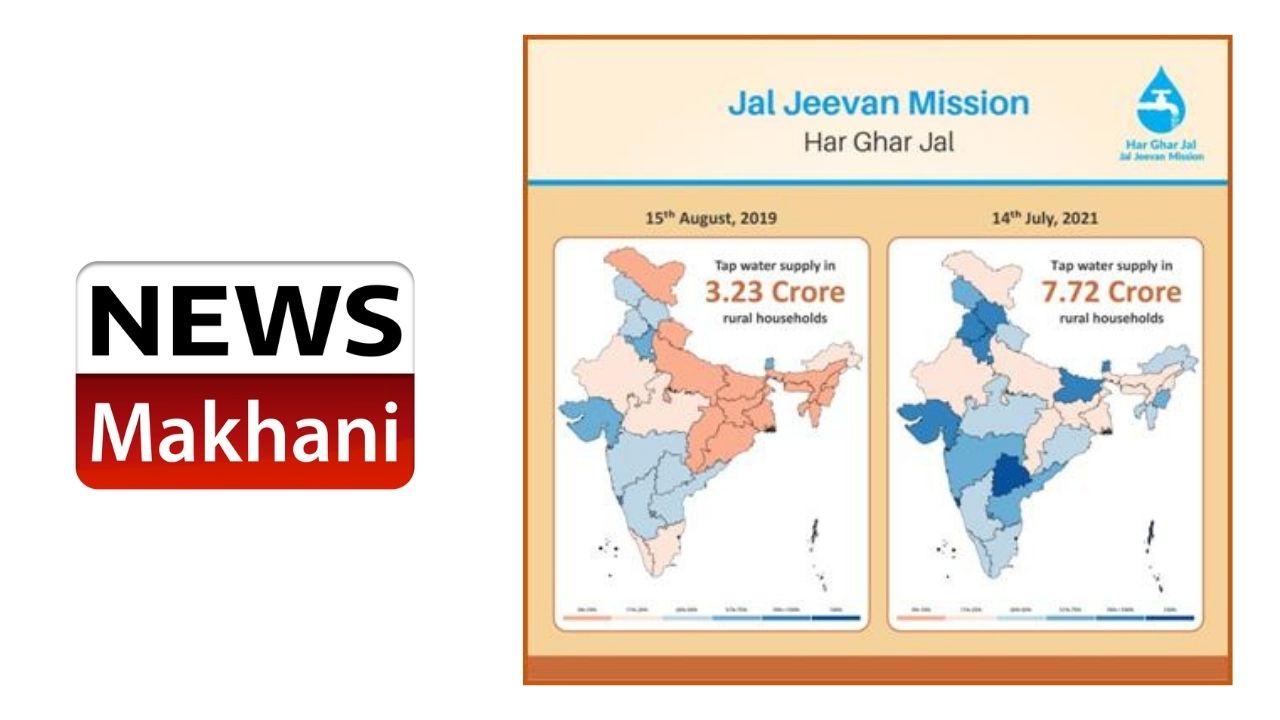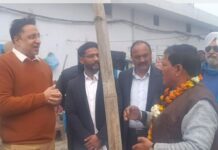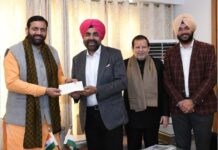Working with speed and scale, Jal Jeevan Mission provides tap water supply to 4.5 Crore households in last 23 months
To translate the Prime Minister Shri Narendra Modi’s vision of providing clean tap water to every household in the country by 2024, Jal Jeevan Mission,working with speed and scale, has today achieved a milestone of providing tap water supply to every household in 1 lakh villages across India, in a short period of 23 months. At the launch of this ambitious programme, out of 18.94 Crore rural households in country, only 3.23 Crore (17%) had tap water connections. Despite Covid-19 pandemic and lockdown disruptions, Jal Jeevan Mission provided 4.49 Crore tap water connections during 23 months and has also made 50 thousand Gram Panchayats ‘Har Ghar Jal’ by providing tap water supply to every household in these panchayats.
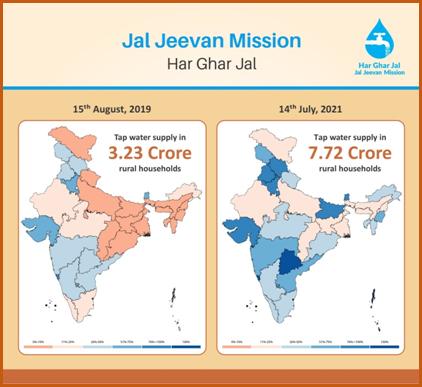
Today tap water supply has reached to 7.72 Crore (40.77%) households. Goa, Telangana, Andaman & Nicobar Islands and Puducherry have achieved 100% tap water supply in rural areas and has become ‘Har Ghar Jal’. Following the principle of Prime Minister’s vision of ‘SabkaSaath, Sabka Vikas, Sabka Vishwas’, the motto of the Mission is that ‘no one is left out’ and every household in a village should be provided with tap water connection. At present, 71 districts, 824 blocks, 50,309 Gram Panchayats and 1,00,275 villages have achieved the target of ‘Har Ghar Jal’.
Announced by the Prime Minister, Shri Narendra Modi on 15th August 2019, in a paradigm shift from earlier water supply programmes, Jal Jeevan Mission focuses on water service delivery rather than providing mere water supply infrastructure. Under JJM, aim is to ensure that every household irrespective of its socio-economic condition, has tap water supply. The JJM is built on the principle of ‘no one is left out’ ensuring poorest of the poor, weaker and marginalized sections of society – those unserved so far, get assured potable tap water supply in their homes. Assured availability of drinking water in homes will save the women and young girls of centuries old drudgery faced by them across rural India. It will improve theirhealth, education and socio- economic conditions. Further, tap water connection in every rural home, brings dignity to the people as it bridges the urban–rural gap and brings ‘ease of living’ in accessing safe water.
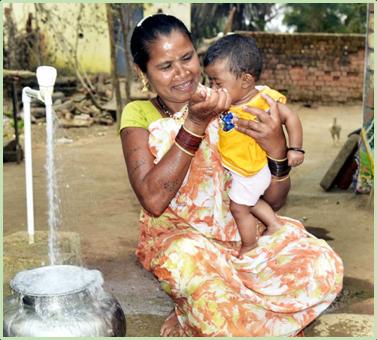
To achieve this mammoth goal of providing tap water supply to every rural household in a short period of five years, Rs 3.60 lakh Crore have been allocated by the government. In 2020-21 an amount of Rs 11,000 Crore was allocated for the States/ UTs.For 2021-22, i.e. current financial year a four-fold increase in fund allocation has been approved by the Union Minister Jal Shakti, Shri Gajendra Singh Shekhawat, so that there is no dearth of fund requirement to achieve the goal. In just three months, Rs 8,891 Crore has been drawn by the States/UTs based on the fund utilization and requirement proposed under their Annual Action Plans (AAPs).
In 2021-22, Rs 26,940 Crore has been allocated to States as 15th Finance Commission tied grant for water & sanitation to Rural Local Bodies/ PRIs. There is an assured funding of Rs 1,42,084 Crore for the next five years i.e. up to 2025-26. This huge investment in rural areas across the country, will accelerate economic activities and boost rural economy. It will create new employment opportunities in villages.
Jal Jeevan Mission is a ‘bottom up’ approach, where community plays a vital role starting from planning to implementation, management, operation & maintenance. To achieve this, State Government has to undertake support activities like strengthening the Village Water & Sanitation Committee (VWSC)/ Pani Samiti, developing of Village Action Plan for next five years, engaging Implementing State Agencies (ISAs) to handhold & support village communities, and carry out awareness among people. So far 2.67 lakh VWSCs or Pani Samitis have been constituted and 1.84 lakh Village Action Plans have been developed across India.
Under Jal Jeevan Mission, water-scarce areas, quality-affected villages, Aspirational districts, SC/ST majority villages and Saansad Adarsh Gram Yojna (SAGY) villages are prioritized for providing tap water supply. During last 23 months, tap water supply has increased four-fold from 7% to 33% in 117 Aspirational districts. Similarly, more than 97 lakh households have been provided with tap water supply in 61 districts affected by Japanese Encephalitis- Acute Encephalitis Syndrome (JE-IES). 696 SAGY villages and 29,063 SC/ST majority villages have become ‘Har Ghar Jal.’
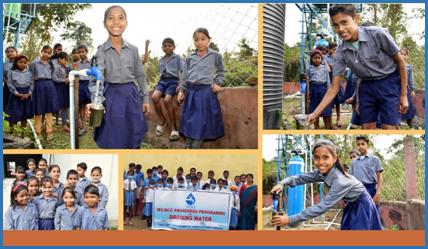
To ensure safe tap water to children in schools, ashramshalas and anganwadicentres in the country, Prime Minister Shri Narendra Modi announced 100-days campaign, which was launched by the Union Minister Shri Gajendra Singh Shekhawat on 2nd October 2020. As a result, States/ UTs like Haryana, Himachal Pradesh, Punjab, Gujarat, Andhra Pradesh, Goa, Tamil Nadu, Telangana, Andaman & Nicobar Islands have made provision of tap water in all schools, ashramshalas and anganwadicentres. So far, 6,76,789 schools (65.7%) and 6,74,611 (59.8%) anganwadicentre across the country have been provided with potable tap water supply in adequate quantity for drinking and cooking mid-day meals, handwashing and use in toilets. Central Government has asked the States/ UTs to ensure that in few months, provision of safe tap water is made in all remaining schools, ashramshalas and anganwadicentres for better health, improved sanitation and hygiene for children.
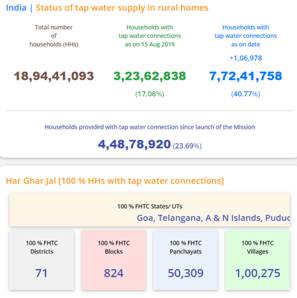
Water quality monitoring & surveillance activities are being given top priority, for which anganwadi workers, ASHA workers, members of Self-Help Groups, PRI members, school teachers etc; are being trained so that they can test water samples for contamination by using Field test Kits (FTKs). There are 2,015 laboratories across the country. 195 water laboratories have been NABL accredited with improved infrastructure and trained technicians. State are upgrading water testing laboratories and securing NABL accreditation. These labs are open to public so that they can get their water samples tested at nominal cost.
Jal Jeevan Mission leverages the use of technology to ensure transparency, accountability, proper utilization of funds and service delivery. A robust JJM-IMIS captures physical and financial progress under JJM with a dedicated Dashboard put out in public domain, which can be accessed at https://ejalshakti.gov.in/jjmreport/JJMIndia.aspx A sensor based IoT solution is piloted for measuring and monitoring water supply with respect to quantity, quality and regularity of water supply in villages on a real-time basis. Every water supply asset created is photo geo-tagged. Hydro-geo morphological (HGM) maps are used in planning single village scheme for identifying drinking water sources as well are constructing aquifer recharge structures. Household tap connections provided under Har Ghar Jal programme are linked with Aadhar number of the head of household and more importantly all financial transactions are undertaken through Public Finance Management System (PFMS).
Working in partnership with States, Jal Jeevan Mission is making all efforts to ensure tap water supply of adequate quantity &in prescribed quality on regular and long-term basis to every rural household in India by 2024.
***

 हिंदी
हिंदी
